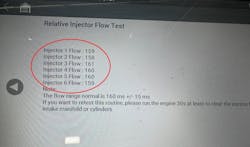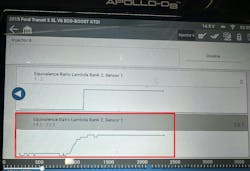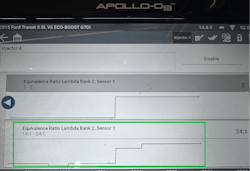I recently had a technical support call from a technician challenged with a misfire. The vehicle was a 2015 Ford Transit with a 3.5L V6 engine and a gasoline direct-injected fueling system, along with 260,000 miles on the odometer. At that mileage, just about anything is possible as a root cause fault.
The initial approach was taken to determine that cylinder No. 6 was the offending cylinder and that the misfire only occurred under heavy engine loads above 65%. I can hugely appreciate the steps taken to determine this. Many technicians do not take the analysis any further than determining which cylinder is misfiring. They frequently discount or even omit the engine operating conditions in which the misfire is occurring. That is a tremendous piece of the puzzle.
A relative compression test was then conducted, and the results took an engine mechanical fault off the list of potential causes within seconds.
Preliminary data
After my initial discussion with the technician, I inquired about the fuel trims (the corrective factor to the chosen injector dosage). According to the technician, the fuel trims were “normal.” I have been doing this a long time and the words “normal” or “good” make me smile. I truly need numbers to evaluate the performance of the vehicle and sub-systems like the GDI system and feedback loop.
I instructed the technician to re-evaluate the fuel trims under the misfiring conditions and get back to me with the results. Considering the nature of when the fault occurred, two potential faults were high on my list of suspects:
- Secondary ignition system fault
- Fuel injector system fault
Although the symptoms are similar from either potential fault, the difference between the two is drastic as how they reflect in fuel trim reaction. Upon revisiting the vehicle, the technician reported back to me with fuel trims exceeding 25% on bank No. 2 (where the suspect cylinder resides).
The abundance of oxygen from the misfiring cylinder provides evidence that the misfiring cylinder lacks fuel (Figure 1). This can be seen in the short-term fuel trim. The fact that only one cylinder is misfiring eliminated a lot of components and unnecessary testing of those components.
A stepping-stone has been provided
My goal is not to “fix the vehicle” but instead to determine what “isn’t broken.” This systematic process of elimination prevents me from wasting time unnecessarily.
I used the preliminary data above to guide me toward the next logical test. In this case, we must focus on the fuel injection system. Particularly, the No. 6 fuel injector's functionality and related circuitry. I instructed the technician to perform a fuel injector balance test.
Now, I will caution you that the injector balance test (specifically regarding a GDI platform) is great at revealing an injector delivery volume issue (a heavy restriction or electrical circuit fault). However, the misfire can be caused by a spray pattern issue which may not be easily reflected in the results of that injector balance test. In other words:
A failed balance test reveals a fault conclusively. A passing test does not prove the system is functioning correctly.
The results of the test left us hanging and offered no conclusive proof of failure (Figure 2). However, we were not dead in the water yet. There is a much more conclusive test I like to perform when I suspect a fuel injector issue and the vehicle is equipped with a wide-band air-fuel ratio sensor (WRAF).
I instructed the technician to use his scan tool to graph out the PID for “Lambda.” I describe this PID as being like the data that would be given from an exhaust gas analyzer in the tailpipe. I continued to instruct the technician to cancel the individual injector’s function with the bi-directional control of the scan tool.
The idea is that each injector (when deactivated) should cause the same change in the exhaust gas content. If any of the injectors’ performance is hindered, when canceled, the change in exhaust gas content will be different from the other properly functioning injectors.
Read more: Don't distress; de-stress your diagnostic process
To save space but prove the value in the test, here are the capture results of a known-good injector cancelation, in GREEN and one from the suspect cylinder, in RED (Figures 3 and 4). What you are seeing is the variation in air-fuel ratio change. It’s quite obvious that the injectors are not performing the same.
The data doesn’t lie
With all the information in front of us and the desired information not yet obtained, we are faced with deciding how to proceed. Here are some bullet points of what we know to be factual:
- The No. 6 cylinder misfires under heavy load.
- Preliminary data points to an injection system fault on bank No. 2.
- Only one cylinder is affected.
- Comparative captures show a variation in exhaust gas content change between cylinders.
Given this information, what would you do next?
- Replace all six fuel injectors to be sure.
- Replace the No. 6 fuel injector only.
- Evaluate the performance of the injection circuit.
- Perform an injection system cleaning service.
SOLVED: (February 2024, Motor Age) 2007 Ford Edge, misfire under load
What would you recommend doing next, given the data bullet points?
Given this information, what would you do next?
- Replace all six ignition coils
- Replace the #2 ignition coil only
- Commit to intake removal and swapping coils for diagnostic purposes
- Obtain a common amperage waveform of all coils
For those of you who chose answer No. 4, congratulations. The amperage waveform is frequently one reflected upon to determine if/how the work is being performed. It will be clear to see if the ignition coil is not functioning properly but also determine if the circuit is functioning correctly.
Although swapping coils from one cylinder to the next is a valuable test, it is not realistic in this application as the suspect coil resides under the intake manifold which must be removed to perform this test.
Replacing all six coils is not a bad idea in this application as they are a quite common weak link in this vehicle’s ignition system and the failure rate is very high. However, that would be an expensive guess. It’s more professional to prove the fault rather than rely on “silver bullet” repair tactics.
Obtaining a common ignition coil waveform will be easy to perform, provide conclusive evidence of coil performance, and doesn’t require any disassembly. In this case, the coil was not performing correctly but had everything it needed to perform correctly (Figure 5). All coils residing under the intake manifold were replaced, including the suspect coil #2. The vehicle was free from misfires after the repair.
This article was originally published on VehicleServicePros.com.
About the Author
Brandon Steckler
Motor Age Technical Editor
Brandon is Technical Editor of Motor Age Magazine. He began his career in Northampton County Community College in Bethlehem, Pennsylvania, where he was a student of GM’s Automotive Service Educational program. In 2001, he graduated top of his class and earned the GM Leadership award for his efforts. He later began working as a technician at a Saturn dealership in Reading, Pennsylvania, where he quickly attained Master Technician status. He later transitioned to working with Hondas, where he aggressively worked to attain another Master Technician status.
Always having a passion for a full understanding of system/component functionality, he rapidly earned a reputation for deciphering strange failures at an efficient pace and became known as an information specialist among the staff and peers at the dealership. In search of new challenges, he transitioned away from the dealership and to the independent world, where he specialized in diagnostics and driveability.
Today, he is an instructor with both CarQuest Technical Institute and WorldPAC Training Institute. Along with beta testing for Automotive Test Solutions, he develops curriculum/submits case studies for educational purposes. Brandon also provides telephone and live technical support, as well as private training, for technicians all across the world.
Brandon holds ASE certifications A1-A9 as well as C1 (Service Consultant). He is certified as an Advanced Level Specialist in L1 (Adv. Engine Performance), L2 (Advanced Diesel Engine Performance) and L3 (Hybrid/EV Specialist).
He contributes weekly to Facebook automotive chat groups, has authored several books and classes, and truly enjoys traveling across the globe to help other technicians attain a level of understanding that will serve them well throughout their careers.





